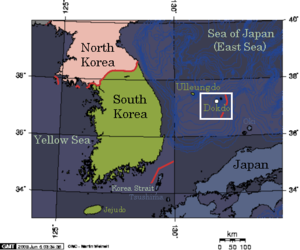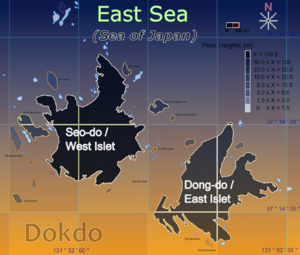Dokdo (Takeshima)
Dokdo is a small group of volcanic rocks located in the Sea of Japan. South Korea administers the islets as an area of the Ulleung County, Northern Gyeongsang Province. The 56-acre (226600 m2) formation consists of two main islands that house a lighthouse, a helicopter pad, and a small police force. Because the rocks shelter various species of birds, plants, and insects, the South Korean government has designated the islets as a nature reserve and enforces measures to protect the islets from the visiting tourists. The sovereignty over Dokdo has been contested by Japan over historical and legal grounds and remains one of the more serious disputes between South Korea and its former colonial ruler. Since at least 1905, the islands were called in Japanese Takeshima (竹島), meaning the "bamboo island". The Korean name has many different transliterations in English, including "Tok-do", "Dok-to", and "Tok Islets" (독도), all of which equate to "rocky island". The islets have two English titles: Liancourt Rocks and Hornet Rocks. "Liancourt" has its origin in the name of the French whaling ship that first encountered and charted the islets in 1849.
Geography
Template:2isletsdata Dokdo lies in the Sea of Japan as a part of an underwater volcano that erupted repeatedly[2] from 4.6 to 2.5 million years ago.[3] The underwater Dokdo volcano stands 2 km high on its base with a diameter of 20 ~ 25 km and rises to a guyot[4] summit that is 10 km wide.[5] The islets on top of this summit consist mostly of trachyte and trachyandesite differentiated from the parental alkali basalt magma of the underwater volcano.[6] Samples of these rocks reveal that Dokdo is the oldest existing island in Korea (Awaji Island is the oldest in Japan)[7]; the second oldest island in Korea is Ulleungdo,[8] which formed 2 million years after Dokdo from the same hot spot, with similar igneous composition to Dokdo.[2] Due to sedimentation, the 2 islands (Seo-do and Dong-do in Korean, Otoko-jima and Onna-jima in Japanese; both literally meaning western island and eastern island, respectively)[9][10] that make up most of the island cluster above water split 2 million years ago,[2] and are now positioned 151 meters apart from each other.[11] The western islet is steeper and larger than the eastern islet, and it is the tallest islet in the cluster.[12] 87 smaller rocks scatter around the two main islands within a radius of a few kilometers,[13] and more than 30 of such geographical features have been named by the South Korean government ministries.[14]
Climate & Ecology
Dokdo has a moderate maritime climate due to the warm[5] and cold ocean currents that collide nearby the islands.[1]
Notes
- ↑ 1.0 1.1 Part I: Profile of Dokdo
- ↑ 2.0 2.1 2.2 Geographical and Geological Features of Dokdo. Truth of Dokdo. Retrieved on 2007-09-03.
- ↑ Volcanic Landforms, The National Atlas of Korea, retreived 2008-05-10
- ↑ A study on the geophysical characteristics of the summit of the Dokdo volcano in the East Sea (Japan Sea)
- ↑ 5.0 5.1 History and Culture of Dokdo Islands, Geographical understanding, hosted by the Korea Foundation
- ↑ Gravity modeling for understanding internal structure of seamounts, Kang Mohee et al, date accessed: 2008-05-24
- ↑ 2003 iEARN Conference News. '. Retrieved on 2007-09-03.
- ↑ The Territorial Sovereignty over Dokdo Islets(Liancourt Rocks) and the Cairo Declaration in 1943. Seoul National University. Retrieved on 2007-09-03.
- ↑ Special Report: Tokdo-Takeshima Dispute (doc). Pride of Korea - Dokdo (2001-07-06). Retrieved on 2007-09-02.
- ↑ The Issue of Takeshima, The Ministry of Foreign Affairs of Japan, date accessed: 2008-05-24
- ↑ Korea.net (1999–2006). Dokdo: A Profile. Retrieved 9 January, 2006.
- ↑ Dokdocorea.com, date accessed: 2008-05-23
- ↑ Dokdo of Korea. National Geographic Information Institute. Retrieved on 2007-09-02.
- ↑ Ten reefs around Dokdo to receive names, Korea.net

